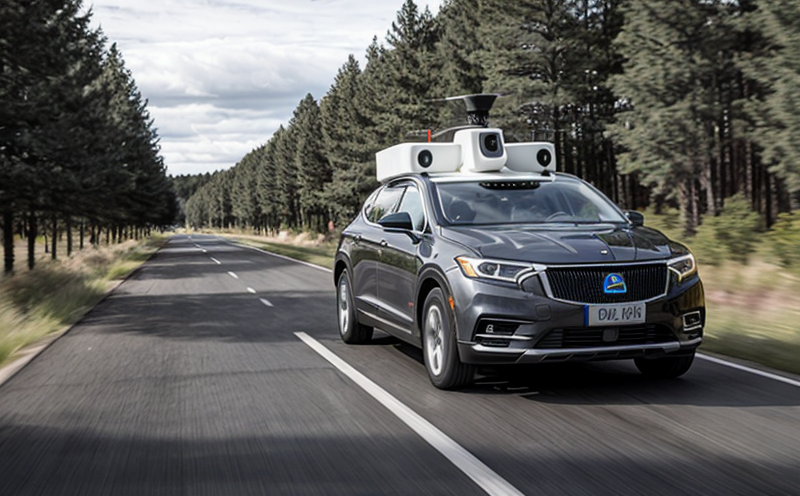ASTM F2560 Multi-Robot Coordination Navigation Testing
The ASTM F2560 standard provides a comprehensive framework for testing and evaluating multi-robot systems in autonomous navigation and coordination. This service ensures that robotic systems can operate reliably, efficiently, and safely in dynamic environments. The focus is on the ability of multiple robots to navigate autonomously while avoiding collisions with each other or obstacles.
Robots used in various sectors such as logistics, manufacturing, healthcare, and public safety rely heavily on autonomous navigation for their functions. Ensuring these systems operate correctly and safely is critical. This service helps manufacturers validate that their robotic systems meet the stringent requirements set by ASTM F2560.
The ASTM F2560 standard defines the parameters of a multi-robot system, including the number of robots involved in the test, the types of environments they will operate in, and the criteria for successful navigation. Testing involves simulating real-world scenarios where multiple robots must navigate through complex terrains while avoiding collisions.
The service includes detailed instrumentation to monitor each robot's performance during testing. Sensors are placed around the test area to detect any movement or obstacles within the environment. These sensors provide real-time data that helps in evaluating how well the robots perform and interact with each other.
Preparation of specimens for this type of testing involves setting up a controlled environment that mimics real-world conditions as closely as possible. This includes creating maps of the test area, placing obstacles, and ensuring all necessary equipment is calibrated correctly. The specimen preparation also involves selecting appropriate robot models based on their intended use.
The ASTM F2560 standard sets strict acceptance criteria for successful completion of tests. Robots must navigate through various predefined paths without colliding with each other or any static objects placed in the environment. They should also be able to detect and avoid dynamic obstacles such as moving personnel or vehicles.
Testing typically involves multiple runs, each designed to evaluate different aspects of multi-robot coordination and navigation capabilities. Post-test analysis includes reviewing sensor data from all robots involved, analyzing collision detection rates, assessing path planning accuracy, and determining overall system reliability.
This service ensures not only compliance with ASTM F2560 but also provides valuable insights into improving robotic systems’ performance in real-world applications. By adhering to this standard, manufacturers can gain a competitive edge by offering safer, more reliable autonomous navigation solutions for their customers.
Applied Standards
- American Society for Testing and Materials (ASTM) F2560-13 Standard Practice for Testing Multi-Robot Coordination and Navigation in Autonomous Systems
The ASTM F2560 standard is widely recognized as the gold standard for testing multi-robot systems. It provides a structured approach to evaluating how well robots can navigate autonomously while avoiding collisions with each other or obstacles.
Compliance with this standard ensures that robotic systems meet the highest safety and performance requirements, which is crucial in sectors like logistics, manufacturing, healthcare, and public safety where autonomous navigation plays a significant role. By adhering to ASTM F2560, manufacturers can demonstrate their commitment to delivering reliable and safe products.
The standard defines several key aspects of multi-robot coordination testing, including the number of robots involved in the test, the types of environments they will operate in, and the criteria for successful navigation. It also provides guidelines on specimen preparation, instrumentation setup, and post-test analysis procedures.
Scope and Methodology
| Aspect | Description |
|---|---|
| Number of Robots | The test involves two or more robots operating in a controlled environment. |
| Test Environment | The environment simulates real-world conditions, including various terrains and obstacles. |
| Instrumentation Setup | Sensors are used to monitor the movement of each robot and detect any collisions or near-misses. |
| Pre-test Preparation | The test area is mapped, and static and dynamic obstacles are placed as per ASTM F2560 guidelines. Robots are calibrated for accurate navigation. |
| Testing Procedure | Robots navigate through predefined paths, avoiding collisions with each other or any obstacles. |
| Data Collection | Sensors record real-time data on robot movements and collision avoidance measures. |
| Post-test Analysis | Data is analyzed to evaluate path planning accuracy, collision detection rates, and overall system reliability. |
The ASTM F2560 standard requires a detailed testing process involving multiple steps. The test begins by setting up the environment according to specified parameters outlined in the standard. Robots are then calibrated for precise navigation before beginning their run through predefined paths designed to challenge their coordination and collision avoidance capabilities.
Data collected during these runs is crucial for understanding how well robots perform under different conditions. This data helps manufacturers identify areas where improvements can be made, ensuring better performance across all systems that comply with ASTM F2560 standards.
Competitive Advantage and Market Impact
- Compliance with ASTM F2560 ensures superior safety features for robotic systems.
- Meeting these stringent requirements can set companies apart from their competitors in the market.
- Robots that pass this test are more likely to gain certification, increasing brand reputation and customer trust.
The competitive advantage gained through compliance with ASTM F2560 is significant. By adhering to this standard, manufacturers demonstrate a commitment to delivering high-quality products that meet the highest safety standards. This can be particularly beneficial in sectors where autonomous navigation systems play an important role.
Meeting these stringent requirements not only enhances product quality but also helps companies stand out from their competitors. When robots pass the ASTM F2560 test, they are more likely to receive certification, which further boosts brand reputation and customer confidence in the products offered.
The market impact of this service extends beyond individual companies; it contributes positively to the overall industry by promoting the development of safer and more reliable autonomous navigation systems. As more manufacturers adopt these practices, consumers can expect improved performance and safety from robotic technologies across various industries.





